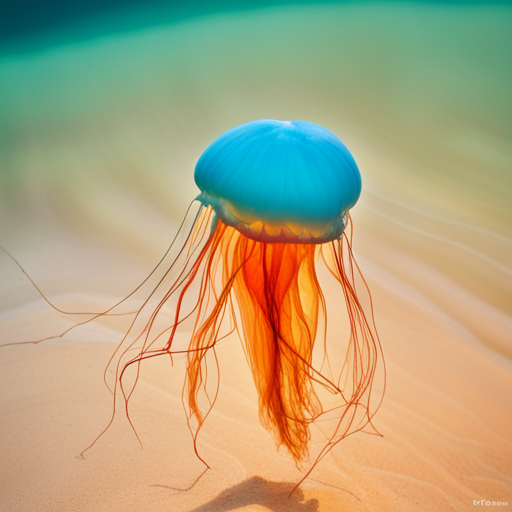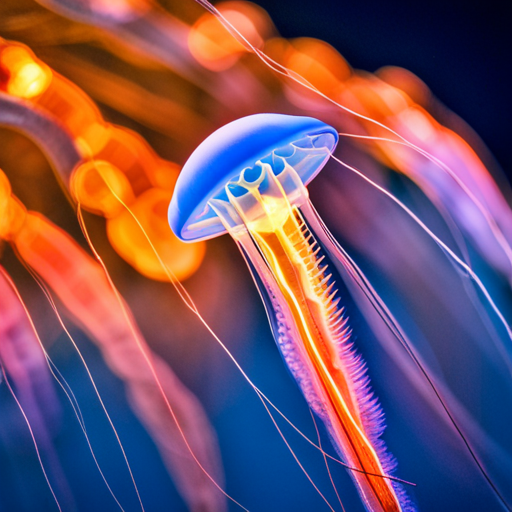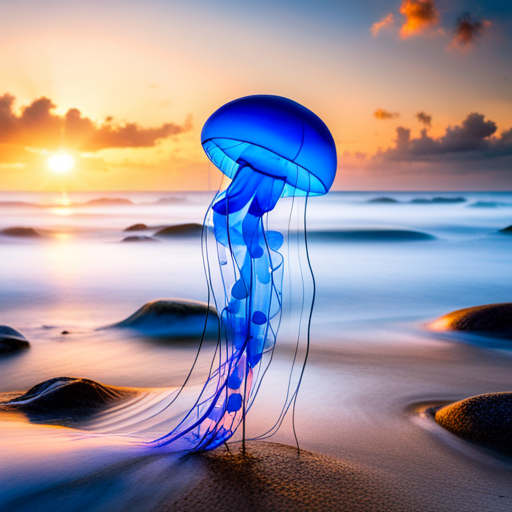Welcome to the mesmerizing world of jellyfish in the Gulf of Mexico, where diversity and beauty abound.
In this comprehensive guide, we will delve into the depths of the Gulf to uncover the captivating secrets of these ethereal creatures. Prepare to be amazed as we explore the vibrancy and majesty of the Moon Jelly, the delicate and hypnotic Sea Nettle, and the awe-inspiring Lion’s Mane, the giant of the Gulf.
We will also uncover the fascinating traits of the Cannonball Jelly and the bioluminescent wonders of the Comb Jellyfish. But beware, we must not forget the notorious Portuguese Man-of-War, a predator like no other in the Gulf.
And finally, we will introduce you to the tiny yet stunning Blue Button jellyfish.
So, join us on this journey of discovery and immerse yourself in the enchanting world of the Gulf’s jellyfish, where freedom and wonder await.
Key Takeaways
- The Gulf of Mexico is home to a diverse range of jellyfish species, including the Moon Jelly, Sea Nettle, Lion’s Mane, Cannonball Jelly, Comb Jelly, Portuguese Man-of-War, and Blue Button jellyfish.
- Jellyfish in the Gulf of Mexico have unique characteristics and roles, such as their transparent appearance for camouflage, stinging cells on tentacles for prey capture and defense, and their importance as prey and nutrient cycling in the marine ecosystem.
- Understanding the distribution patterns and feeding habits of jellyfish in the Gulf of Mexico is crucial for conservation efforts.
– While jellyfish can cause annoyance, irritation, discomfort, and nuisance to humans, the level of annoyance varies among different jellyfish species.
Moon Jelly: A Closer Look at this Vibrant and Ethereal Species
Take a closer look at the moon jelly, with its translucent bell and delicate tentacles gently pulsating as it gracefully glides through the sparkling waters of the Gulf of Mexico. The moon jelly, scientific name Aurelia aurita, is one of the most common and captivating jellyfish species found in the Gulf.
Its life cycle is truly fascinating, starting as a tiny polyp attached to a surface, then transforming into a free-swimming medusa, and finally reproducing by releasing eggs and sperm into the water. This species has a relatively short lifespan, typically living for about one year.
Despite its ethereal beauty, the moon jelly has a significant ecological impact in the Gulf of Mexico. As filter feeders, they play a crucial role in maintaining the balance of marine ecosystems. They consume small planktonic organisms, helping to control their populations and preventing overgrowth. Additionally, moon jellies serve as a food source for various marine creatures, including sea turtles and certain fish species.
The moon jelly’s translucent appearance is not only visually stunning but also serves as a defense mechanism. Its transparent bell helps it blend into the water, making it less visible to potential predators. The delicate tentacles, which are lined with thousands of tiny stinging cells called cnidocytes, allow the moon jelly to capture prey and defend itself when threatened.
The moon jelly is a mesmerizing species that contributes to the ecological balance of the Gulf of Mexico. Its life cycle and ecological impact highlight the importance of preserving and appreciating the diversity and beauty of these magnificent creatures.
Sea Nettle: Exploring the Mesmerizing Beauty of this Delicate Jellyfish

Immerse yourself in the captivating world of the Sea Nettle, and prepare to be swept away by its ethereal charm. Exploring the graceful movements of sea nettles is like witnessing a ballet in the ocean.
These delicate creatures gracefully glide through the water, their long, translucent tentacles trailing behind them. As they pulse and undulate, their mesmerizing beauty is truly a sight to behold.
Sea nettles, scientifically known as Chrysaora quinquecirrha, play a significant role in the Gulf of Mexico’s marine ecosystem. They are voracious predators, feeding on small fish, crustaceans, and even other jellyfish. Despite their delicate appearance, their tentacles are armed with venomous stinging cells, which they use to immobilize their prey. This ability allows them to maintain their dominance in the marine food chain.
Understanding the ecological impact of sea nettles on marine life is essential to preserving the delicate balance of the Gulf of Mexico’s ecosystem. While they may be beneficial in controlling populations of certain prey species, an overabundance of sea nettles can have detrimental effects. Their voracious appetite can deplete the populations of small fish and crustaceans, disrupting the food chain and leading to imbalances in the ecosystem.
Exploring the world of sea nettles reveals their graceful movements and highlights their ecological impact on marine life. These mesmerizing creatures showcase the delicate beauty that can be found beneath the surface of the Gulf of Mexico’s waters.
Lion’s Mane: Discover the Majestic Giant of the Gulf

Get ready to encounter the breathtaking presence of the Lion’s Mane, a majestic giant that commands attention in the depths of the ocean. With its long tentacles and vibrant coloration, the Lion’s Mane jellyfish is a captivating creature that can reach sizes of up to 8 feet in diameter. Its name is derived from its mane-like appearance, resembling the flowing locks of a lion.
To uncover the mysteries of its sting and life cycle, let’s take a closer look at the Lion’s Mane jellyfish. The Lion’s Mane possesses specialized cells called nematocysts, which are responsible for delivering its potent venom to prey and potential threats. The sting of a Lion’s Mane can cause mild to severe discomfort in humans, and individuals with allergies may experience more severe reactions. However, it is important to note that the sting of a Lion’s Mane is rarely fatal.
The life cycle of a Lion’s Mane is truly fascinating. It begins as a tiny larva that grows into a polyp, attaching itself to a substrate on the ocean floor. From there, it develops into a medusa, or adult jellyfish, and begins its journey through the water column. The medusa stage is when the Lion’s Mane displays its mesmerizing beauty, with its long, flowing tentacles and pulsating bell.
Climate change has been shown to have an impact on the population dynamics of the Lion’s Mane jellyfish. As ocean temperatures rise, these jellyfish are able to expand their range and thrive in new areas. This can lead to an increase in encounters with humans, as well as potential disruptions to marine ecosystems.
The Lion’s Mane jellyfish is a magnificent creature that captivates with its beauty and commands attention with its size. Uncovering the mysteries of its sting and life cycle sheds light on the intricate workings of this mesmerizing species. Additionally, understanding the role of climate change on its population dynamics is crucial for managing and conserving our ocean ecosystems. So, next time you encounter a Lion’s Mane, remember to appreciate its beauty from a safe distance.
Cannonball Jelly: Uncovering the Fascinating Traits of this Curious Jellyfish

When it comes to the Cannonball Jelly, there are two key points to discuss: its anatomy and defense mechanisms, as well as its role in the ecosystem.
The Cannonball Jelly has a unique anatomy, with a bell-shaped body and long, slender tentacles. Its defense mechanisms include stinging cells called nematocysts, which it uses to deter predators and capture prey.
In the ecosystem, the Cannonball Jelly plays an important role as a food source for many marine animals, and its abundance can indicate the health of the surrounding environment.
Anatomy and Defense Mechanisms
Explore the intricate anatomy and fascinating defense mechanisms of jellyfish in the Gulf of Mexico, and marvel at their beauty and diversity.
Jellyfish have evolved unique anatomical features and defense mechanisms to survive in their marine environment.
- Nematocysts: These specialized cells found on the tentacles are armed with stinging capsules called nematocysts. When triggered by touch or chemical signals, the nematocysts release venomous threads that immobilize prey or deter predators.
- Bioluminescence: Some jellyfish species possess bioluminescent capabilities, producing a mesmerizing light show. This adaptation serves multiple purposes, including attracting prey, confusing predators, and communicating with other jellyfish.
- Transparency: Many jellyfish species are almost transparent, allowing them to blend seamlessly with their surroundings. This camouflage helps protect them from visual detection by predators, giving them an advantage in their quest for survival.
With their arsenal of defense mechanisms and their unique anatomical adaptations, jellyfish in the Gulf of Mexico showcase the remarkable diversity and resilience of these enigmatic creatures.
Role in the Ecosystem
Playing a crucial role in the marine ecosystem, jellyfish in the Gulf of Mexico contribute to the delicate balance of life beneath the waves. These gelatinous creatures play various important roles, impacting both the physical and biological aspects of the ecosystem. Firstly, they serve as prey for numerous marine species, including sea turtles and some fish, providing a vital source of food. Additionally, jellyfish help to regulate the populations of their prey, acting as natural predators and preventing certain species from becoming too abundant. They also contribute to nutrient cycling by consuming plankton and other small organisms and excreting waste that enriches the surrounding water. Furthermore, jellyfish serve as indicators of the overall health of the ecosystem, as their numbers can increase or decrease in response to changes in environmental conditions. Overall, the presence and abundance of jellyfish in the Gulf of Mexico are of great importance and have a significant impact on the ecosystem’s functioning.
Comb Jellyfish: The Bioluminescent Beauties of the Gulf

Witness the mesmerizing beauty of comb jellyfish in the Gulf of Mexico, where their bioluminescent glow illuminates the waters, with over 40 different species creating a breathtaking spectacle.
Comb jellyfish, scientifically known as ctenophores, aren’t actually jellyfish but are often mistaken for them due to their gelatinous appearance. These ethereal creatures possess rows of cilia, known as comb plates, which they use to propel themselves through the water, creating a mesmerizing display of shimmering lights.
Bioluminescent behavior is a defining characteristic of comb jellyfish. They produce their own light through a chemical reaction within their cells, allowing them to emit a soft, otherworldly glow. This bioluminescence serves several purposes for these creatures. It aids in communication, attracting potential mates or signaling predators. It also acts as a defense mechanism, as the bright lights can startle or confuse predators, giving the comb jellyfish a chance to escape.
The ecological significance of comb jellyfish can’t be overstated. They play a crucial role in the Gulf of Mexico’s food web, serving as both predators and prey. Comb jellyfish feed on smaller organisms, such as copepods and fish larvae, helping to control their populations. At the same time, they’re a vital food source for larger predators, including sea turtles and certain species of fish.
The comb jellyfish of the Gulf of Mexico exhibit a captivating bioluminescent behavior that adds to their allure. Their ecological significance can’t be ignored, as they play a vital role in maintaining the delicate balance of the Gulf’s ecosystem. So, next time you find yourself in the Gulf, take a moment to appreciate the beauty and importance of these bioluminescent beauties.
Portuguese Man-of-War: Understanding the Notorious Predator of the Gulf
Immerse yourself in the treacherous world of the Portuguese Man-of-War, as its venomous tentacles and vivid colors evoke a sense of danger lurking beneath the surface. This notorious predator of the Gulf of Mexico isn’t actually a single organism, but a colony of specialized individuals called zooids, working together to survive and hunt.
The Portuguese Man-of-War, or Physalia physalis, is named after its resemblance to a 16th-century Portuguese warship. While it may appear to be a jellyfish, the Portuguese Man-of-War is actually a siphonophore, a group of specialized organisms that function as a single unit. It consists of a gas-filled float that sits on the surface of the water, and long, trailing tentacles that can extend up to 165 feet. These tentacles are equipped with venomous cells called nematocysts, which can deliver painful stings to its prey or any unfortunate swimmer that comes into contact with them.
The impact of the Portuguese Man-of-War on marine life is significant. Its predatory behavior allows it to feed on small fish, crustaceans, and even other jellyfish. The venomous tentacles not only immobilize its prey, but also deter potential predators. However, its presence can be detrimental to other marine organisms, as it competes for resources and can disrupt the delicate balance of the ecosystem.
As you explore the Gulf of Mexico, keep a safe distance from the Portuguese Man-of-War, appreciating its beauty from afar. Remember, its striking colors and venomous tentacles serve as a warning of the danger it possesses. Stay vigilant and respect the delicate harmony of the underwater world, where freedom reigns for all creatures that call it home.
Blue Button: An Introduction to the Tiny but Stunning Jellyfish of the Gulf

Blue Button jellyfish, also known as Porpita porpita, are tiny but visually captivating creatures found in the Gulf of Mexico. They have a distinct appearance with a round, flattened body and vibrant blue coloration.
Blue Buttons are widely distributed across the Gulf, often seen floating near the water’s surface. These jellyfish display a unique behavior of forming colonies, with multiple individuals connected by a common stalk.
Despite their small size, Blue Buttons are capable of delivering a painful sting, making them an intriguing subject for further study in the Gulf ecosystem.
Size and Appearance
Little did we expect that the jellyfish of the Gulf of Mexico would come in such a fascinating array of sizes and appearances. These mesmerizing creatures exhibit a wide range of sizes, from the minuscule Blue Button jellyfish, measuring only a few millimeters in diameter, to the awe-inspiring Lion’s Mane jellyfish, which can grow to be several meters long.
Additionally, the Gulf of Mexico is home to a plethora of jellyfish species, each displaying its own unique color variations. Some jellyfish species showcase vibrant hues of blue and purple, while others exhibit a more subdued palette of whites and yellows. These color variations serve various purposes, such as camouflage or attracting prey.
The diverse sizes and appearances of the jellyfish in the Gulf of Mexico make exploring their world a truly captivating experience.
Distribution and Behavior
One fascinating aspect to explore is how these captivating creatures are distributed throughout their habitat and how their behavior varies from species to species.
Jellyfish distribution patterns in the Gulf of Mexico are influenced by ocean currents, temperature, and food availability. Some species prefer shallow coastal waters, while others are found in deeper offshore regions.
Jellyfish are known to exhibit both passive and active swimming behaviors. They can drift with ocean currents, but also have the ability to move against the current using their bell-shaped bodies.
Jellyfish feeding habits vary depending on the species. Some are filter feeders, using their tentacles to capture plankton and small organisms. Others are predatory, using their venomous tentacles to stun or kill their prey.
Understanding these distribution patterns and feeding habits is crucial for studying and conserving these beautiful creatures.
- Witness the mesmerizing sight of jellyfish gracefully drifting in the Gulf of Mexico.
- Discover the incredible diversity of jellyfish species and their unique habitats.
- Explore the intriguing behaviors of jellyfish, from passive drifting to active swimming.
– Marvel at the intricate feeding strategies employed by different jellyfish species.
Frequently Asked Questions
How many different species of jellyfish are found in the Gulf of Mexico?
The jellyfish population dynamics in the Gulf of Mexico are influenced by climate change. It is unknown how many different species of jellyfish are found in the region due to the lack of comprehensive studies.
Are there any dangerous or venomous jellyfish species in the Gulf of Mexico?
Yes, there are venomous jellyfish species in the Gulf of Mexico. However, by following proper jellyfish sting prevention methods, such as avoiding contact and wearing protective clothing, you can enjoy the freedom of exploring these beautiful creatures safely.
What is the lifespan of jellyfish in the Gulf of Mexico?
The lifespan of jellyfish in the Gulf of Mexico varies depending on several key factors. These factors include environmental conditions, availability of food, and predation. The average lifespan of jellyfish in the Gulf of Mexico ranges from a few months to a year.
How do jellyfish reproduce and what is their mating behavior in the Gulf of Mexico?
Jellyfish reproduction in the Gulf of Mexico involves fascinating reproductive strategies and intricate mating rituals. These include a combination of external fertilization, internal brooding, and a variety of courtship displays. Exploring these behaviors offers a deeper understanding of their complex life cycle.
What are the major threats to jellyfish populations in the Gulf of Mexico?
The major threats to jellyfish populations in the Gulf of Mexico include coral reef conservation and the impact of climate change. These factors can disrupt the delicate balance of their ecosystem and negatively affect their survival.
Conclusion
As you conclude your journey through the diverse and beautiful world of Gulf of Mexico jellyfish, take a moment to reflect on the intricate web of life that exists beneath the waves.
Like the delicate tentacles of the Sea Nettle, each species plays a vital role in maintaining the balance of this underwater ecosystem.
Just as the Moon Jelly’s ethereal glow captivates our senses, these creatures remind us of the mesmerizing wonders that await us in the depths.
So dive in, explore, and let the rhythm of the ocean guide you to the stunning beauty that lies beneath its surface.
